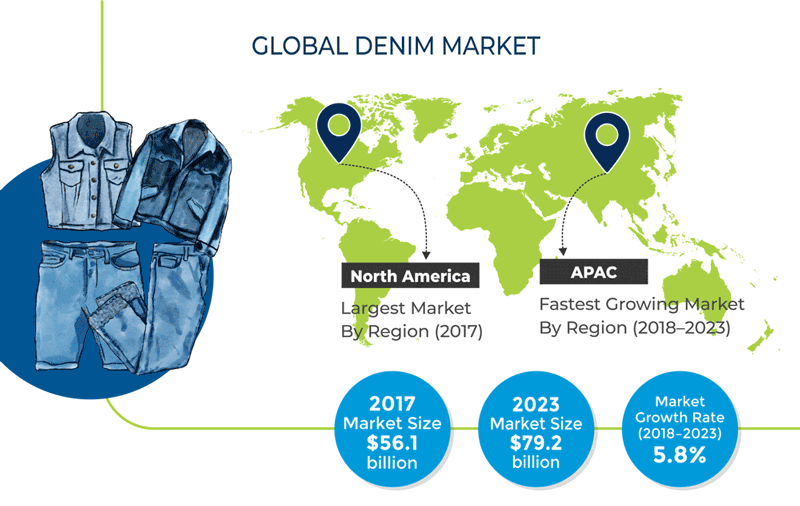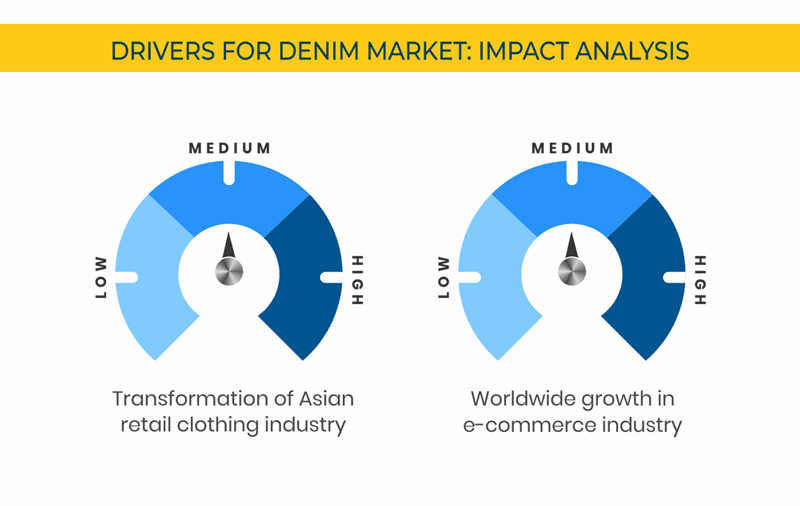Report Code: 10569 | Available Format: PDF | Pages: 140
Denim Market by Product (Jeans, Jackets & Shirts, Dresses), by Segment (Mass Market, Standard, Premium), by Consumer Type (Men, Women, Children), by Distribution Channel (Specialty Stores, Department Stores, Hypermarkets & Supermarkets, Online, Exclusive Stores), by Geography (U.S., Canada, Germany, France, U.K., Italy, Spain, Netherlands, Russia, Belgium, China, Japan, India, Philippines, South Korea, Australia, Pakistan, New Zealand, Thailand, Malaysia, Vietnam, Brazil, Mexico, Turkey, U.A.E., Saudi Arabia, South Africa) - Global Market Size, Share, Development, Growth and Demand Forecast, 2013 - 2023
- Report Code: 10569
- Available Format: PDF
- Pages: 140
- Report Description
- Table of Contents
- Market Segmentation
- Request Free Sample
The global denim market valued at $56.1 billion in 2017 and projected to witness 5.8% CAGR by 2023. Asia-Pacific (APAC) is expected to witness the fastest growth in the market, during the forecast period. This can be attributed to the rising disposable income of the people, easy availability of raw materials, and increasing government initiatives for manufacturing of products in the countries such as China, Vietnam, and India.

Forces Governing the Denim Market
The shifting inclination of consumers toward distressed, cropped, and patched jeans is a key trend in the market. People across the globe are increasingly focusing on trending jeans, including those with cropped hems, as well as boyfriend jeans, two-tone jeans, and skinny jeans. These styles are gaining huge momentum among consumers, especially the younger population, owing to their casual look and promotions through media. Additionally, decorative denims with details such as patches, laces, and embroidery are also being rapidly sold in the denim market.
Proper disposal of used clothes and plastics is becoming a major concern for global environmentalists. The use of large quantities of hazardous chemicals and high emissions of greenhouse gases during the production of denim have been creating a negative impact on the climate. Owing to this, denim manufacturers are now concentrating on effectively controlling the consumption of chemicals, to reduce the degrading environmental effects, by adopting sustainable practices, which is raising the demand for denim recycling across the globe. The concept of sustainable denim clothing is not only gaining popularity in developed nations, such as the U.S. and Germany, but also in developing countries, including China and India. Hence, the growing production of denim from plastic and other recyclable materials is a major opportunity for the denim market players.

Denim Market Segmentation Analysis
The online distribution channel is expected to register the fastest growth in the denim market during the forecast period. This can be attributed to the rapidly growing e-commerce industry around the globe, with the populace inclining toward online shopping. Additionally, customers now want convenient on-demand shopping, via a platform that lets them choose from a variety of products. Owing to this, the online market for denim clothing is expected to witness robust growth, globally, in the coming years.
Men held the largest share in the market in 2017, due to their high demand for rugged-material and casual clothing. Denim clothing is worn by male consumers for various purposes, such as parties, everyday life, and work.
Geographical Analysis of the Denim Market
Globally, North America was the largest market for denim, in terms of revenue, during the historical period (2013–2017). The growing demand for superior-quality clothing, rising disposable income, and increasing promotion of denimwear by celebrities are the key factors driving the growth of the market in the region.
However, the denim market in APAC is projected to witness the highest CAGR during the forecast period, owing to the improving manufacturing process, swift urbanization, bettering standard of living, increasing disposable income, and expanding working-class population.

Recent Strategic Developments of Major Denim Market Players
The denim market is fragmented in nature. The key players operating in the market include Levi Strauss & Co., The Gap Inc., VF Corporation, H & M Hennes & Mauritz AB, PVH Corp., Kering, Pepe Jeans, S.L., Bestseller A/S, and U.S. Polo Assn. In recent years, the major players in the global denim market have taken several strategic measures, such as product launches, mergers & acquisitions, partnerships, and facility expansions, to strengthen their position in the industry. For instance, in April 2018, VF Corporation completed the acquisition of Icebreaker Holdings Ltd., a privately held merino-wool outdoor and natural-performance outdoor clothing company based in Auckland, New Zealand, for an undisclosed amount. Through this acquisition, the former company aims to become a global leader in merino-wool denim and natural-fiber clothing.
Market Size Breakdown by Segment
The Denim market report offers comprehensive market segmentation analysis along with market estimation for the period 2013–2023.
Based on Product
- Jeans
- Jackets and shirts
- Dresses
Based on Segment
- Mass market
- Standard
- Premium
Based on Consumer Type
- Men
- Women
- Children
Based on Distribution Channel
- Specialty stores
- Department stores
- Online
- Hypermarkets and supermarkets
- Exclusive stores
Geographical Analysis
North America
- U.S.
- Canada
Europe
- Germany
- U.K.
- France
- Italy
- Spain
- Netherlands
- Russia
- Belgium
Asia-Pacific (APAC)
- China
- India
- Japan
- South Korea
- Philippines
- Australia
- Pakistan
- New Zealand
- Thailand
- Malaysia
- Vietnam
Latin America (LATAM)
- Brazil
- Mexico
Middle East & Africa (MEA)
- Turkey
- U.A.E.
- Saudi Arabia
- South Africa
Key Questions Answered in the Report
- What is the current scenario of the denim market?
- What are the key strategies companies are adopting to increase their consumer base?
- What are the key categories within the market segments and their future potential?
- What are the major growth drivers for the market and their expected impact during the short, medium, and long terms?
- What are the opportunities for the players in the market?
- What are the major factors hindering the growth of the market?
- Which are the key regions from the investment perspective?
Want a report tailored exactly to your business strategy?
Request CustomizationWant an insight-rich discussion with the report author?
Speak to AnalystOur dedication to providing the most-accurate market information has earned us verification by Dun & Bradstreet (D&B). We strive for quality checking of the highest level to enable data-driven decision making for you
Our insights into the minutest levels of the markets, including the latest trends and competitive landscape, give you all the answers you need to take your business to new heights
With 24/7 research support, we ensure that the wheels of your business never stop turning. Don’t let time stand in your way. Get all your queries answered with a simple phone call or email, as and when required
We take a cautious approach to protecting your personal and confidential information. Trust is the strongest bond that connects us and our clients, and trust we build by complying with all international and domestic data protection and privacy laws